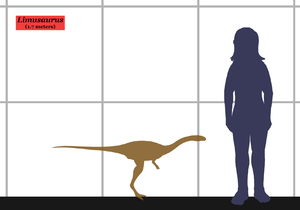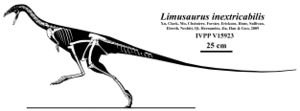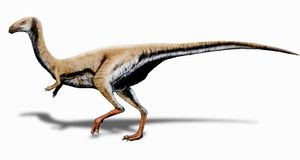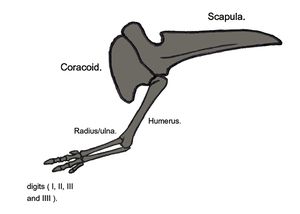ليموصور
| Limusaurus | |
|---|---|

| |
| Two fossil specimens exhibited in Tokyo (slab also contains a small crocodyliform) | |
| التصنيف العلمي | |
| أصنوفة غير معروفة (أصلحها): | Limusaurus |
| Species: | Template:Taxonomy/LimusaurusL. inextricabilis
|
| Binomial name | |
| Template:Taxonomy/LimusaurusLimusaurus inextricabilis Xu et al., 2009
| |
Limusaurus (meaning "mud lizard") is a genus of toothless herbivorous theropod dinosaur from the Jurassic (Oxfordian stage) Upper Shishugou Formation in the Junggar Basin of western China. The genus contains a single species, L. inextricabilis. Limusaurus is the first definitely known ceratosaur from Eastern Asia, including China.[1][2]
Description
Limusaurus had a small, slender body measuring about 1.7 متر (5 ft 7 in) in length. It had a short, toothless skull and jaw, about half the length of the femur. The skull ended with a beak covering the slightly convex premaxilla; beaks such as this had previously only been reported in coelurosaurs among theropods. The nasal bone was short and wide relative to the entire skull, and was ridged on each side, the lacrimal bone sloped downwards sharply over the eyes, and the branches of the jugal bone were slender and rod-like. The fenestra of the mandible was quite large, being 40% the length of the entire lower jaw. The eye socket was relatively large, and the neck was long.[1]
The sternum of Limusaurus was fused into a single, large, continuous plate, likewise convergent upon coelurosaurs. It also possesses a furcula, or wishbone, which previously was unknown among ceratosaurs. The scapula bore a prominent ridge at its front end. The arms and hands of Limusaurus were considerably reduced; the first finger was small and lacked phalanges entirely, while the second finger was very robust, and the (incompletely preserved) fourth finger was comparatively long and slender. The radius tightly adhered to and was longer than the ulna. The "boot" of the pubis pointed backwards in a hook-like shape and had a ridge on each side. Gastroliths in the stomach of adult specimens are further indications of a herbivorous diet.[1]
The legs of Limusaurus were quite long, being 1.8 times the length of the torso. The fused tibiotarsus was 1.2 times the length of the femur, and the rest of the foot was 1.3 times the length of the femur. This made Limusaurus well-adapted to running. The first toe, or the hallux, was extremely reduced, being only 17% the length of the third metatarsal. The metatarsals of the second to fourth toes were arranged in an arc, with the fourth metatarsal adhering tightly to the third for its entire length.[1]
Ontogeny
Juvenile specimens of Limusaurus show a sequence of 78 different morphological changes that occur as the animal grows. Overall, relative to juveniles, the heads of subadults and adults become shallower, their second metacarpals lengthen, and the "hook" of their pubic boots grows longer. Additionally, the shaft of the quadrate bone straightens in adults, the tip of the lower jaw becomes more downturned, and gastroliths are more often associated with the skeletal remains. In particular, more mature specimens have gastroliths that are greater in size and quantity.[3]
Perhaps the most radical change throughout the growth of Limusaurus is that juveniles are toothed, whereas adults are completely toothless. Juveniles begin with one tooth in the premaxilla, eight in the maxilla, and eleven in the lower jaw (42 teeth total). At the next stage, the first, sixth, and eighth teeth in the maxilla, as well as the sixth in the lower jaw have all been lost (34 teeth total), although the sockets are still present, and there is a small replacement tooth in the socket of the sixth lower tooth. During this stage, usage of teeth and normal tooth replacement likely became reduced, since none of the still-erupted teeth bear any marks of wear or resorption. As specimens grow, the transformation becomes more radical. In adults, all of the teeth are missing. CT scanning shows that only five empty tooth sockets remain in the adult maxilla; all of the sockets in the lower jaw have fused into a single, hollow canal, and the rest of the tooth sockets have been obliterated.[3]
Discovery and naming
Limusaurus was described in a 2009 paper authored by Xu et al. in the journal Nature. The initial description incorporated data from subadult specimens found in close association; the holotype, (IVPP) V 15923, is an almost complete articulated skeleton, and the other, IVPP V 15924, is a nearly completely articulated specimen, only missing the skull. The second specimen is 15% larger than the holotype. A third referred specimen is IVPP V16134.[1]
Subsequent discoveries of new specimens brought the total number of specimens up to 19. These specimens are known from three different aggregations, with two being at the same level and one some 6.5 متر (21 ft) higher in the stratigraphic column; they cover a range of ages from yearlings to 10-year-old individuals. Like the holotype and paratype, the new specimens are also stored at the Institute of Vertebrate Paleontology and Paleoanthropology.[3] All of the above specimens were found in Oxfordian deposits, as part of the upper Shishugou Formation in the Junggar Basin of Xinjiang, China.[1]
Both the genus name, Limusaurus (meaning "mud lizard"), and the name of the type species, L. inextricabilis (meaning "impossible to extricate"), refer to how the first two specimens died after presumably being mired in mud.[1]
Classification
Limusaurus is a basal ceratosaur that shares many characteristics with coelophysoids and tetanurans. The features present in Limusaurus is suggestive of a close relationship between the clades Ceratosauria and Tetanurae.
The following cladogram is based on the phylogenetic analysis conducted by Rauhut and Carrano in 2016, showing the relationships of Limusaurus among the noasaurids:[4]
| Abelisauroidea |
| ||||||||||||||||||||||||||||||||||||||||||
Paleobiology
Evolutionary convergence
Limusaurus shares several features of the head with basal theropods such as other ceratosaurs and coelophysoids, but it also convergently shares a number of features, including the beak and the fused sternum, with the later coelurosaurs. It was also the earliest theropod to have become adapted to eating plants. The overall aspect of the animal, including the long neck and legs, is very similar to that of the Cretaceous ornithomimid theropods, as well as the Triassic non-dinosaurian archosaur Effigia, representing a remarkable case of convergent evolution among these three distinct groups of archosaurs.[1]
Ontogeny
The loss of teeth with age in Limusaurus is the most extreme case of tooth morphology changing with age among dinosaurs. In fact, it is one of the only known jawed vertebrates where teeth are completely lost during ontogeny (the others are the red mullet and striped red mullet,[5] several armored catfish,[6] and the platypus[7]). Its complicated pattern of losing teeth from both the front and the back is most similar to that of Jeholornis.[8] The temporary halt in tooth replacement likely results from the replacement tooth buds regressing, as in the veiled chameleon.[9][3]
Isotope analysis of the Limusaurus specimens show that, while end-stage adults consistently match the isotope signatures of other herbivorous dinosaurs, juveniles and subadults vary greatly in their isotopic signatures. This indicates that juveniles were likely omnivorous, but switched to strict herbivory as they aged.[3] This is similar to the diet shift experienced by the aforementioned mullets[5] and armored catfish.[6]
Digit homology
It was traditionally thought that the hands of dinosaurs evolved into the wings of birds by the disappearance of the two outward digits (IV and V), in contradiction to embryological studies on birds that showed that the retained digits are the three middle ones (II–III–IV). The hand structure of Limusaurus with its reduced digit I adds more weight to the digit II–III–IV identities for Tetanurae, the group which includes birds. Previous to the discovery of Limusaurus, theropods were assumed to have progressively evolved reduced digits on the ulnar side of the manus. This concept, known as Lateral Digit Reduction (LDR), is in contrast to Bilateral Digit Reduction (BDR), the reduction on digits on both sides of the hand commonly seen in all other tetrapod groups excluding dinosaurs. However, in Limusaurus, the first digit (digit I) is strongly reduced, along with other ceratosaurs, suggesting that BDR occurred in their sister group the Tetanurae as well.[1]
Previously, it was thought that digits I–III were retained in tetanurans as a homology with basal theropods, giving credence to the LDR hypothesis. However, the evidence of BDR in Limusaurus suggests that other non-avian theropods may also have exhibited BDR and the apparent digits I–III in tetanurans may actually be digits II–IV, a previous idea considered by Thulborn and Hamley, but largely ignored in the paleontological community.[1][10] Despite the interesting possibilities raised by Limusaurus, it is unlikely that researchers will stop referring to tetanuran digits as I, II, and III, and switch to calling them II, III, IV. This is because most of their morphological traits resemble those of digits I, II and III of other theropods. It remains possible that bilateral digit reduction occurred in Ceratosauria but not in Tetanurae. The embryology of the bird wing could be explained by a homeotic frameshift of digital identity, as suggested by recent gene expression and experimental data.[11]
Paleoecology
Limusaurus is the first definite ceratosaur from eastern Asia to be discovered, and one of the earliest members of the group. Its discovery shows that the Asian dinosaurian fauna was less endemic during the Middle/Late Jurassic period than previously thought, and suggests a possible land connection between Asia and other continents during that period.[1]
See also
الهامش
- ^ أ ب ت ث ج ح خ د ذ ر ز Xu, X.; Clark, J.M.; Mo, J.; Choiniere, J.; Forster, C.A.; Erickson, G.M.; Hone, D.W.E.; Sullivan, C.; Eberth, D.A.; Nesbitt, S.; Zhao, Q.; Hernandez, R.; Jia, C.-K.; Han, F.-L.; Guo, Y. (2009). "A Jurassic ceratosaur from China helps clarify avian digital homologies". Nature. 459 (18): 940–944. doi:10.1038/nature08124.
- ^ New dinosaur gives bird wing clue. BBC News, June 17, 2009.
- ^ أ ب ت ث ج Wang, S.; Stiegler, J.; Amiot, R.; Wang, X.; Du, G.-H.; Clark, J.M.; Xu, X. (2017). "Extreme Ontogenetic Changes in a Ceratosaurian Theropod" (PDF). Cell Biology. 27: 1–5. doi:10.1016/j.cub.2016.10.043.
- ^ Rauhut, O.W.M.; Carrano, M.T. (2016). "The theropod dinosaur Elaphrosaurus bambergi Janensch, 1920, from the Late Jurassic of Tendaguru, Tanzania". Zoological Journal of the Linnean Society. 178 (3): 546–610. doi:10.1111/zoj.12425.
- ^ أ ب Aguirre, H. (1997). "Presence of dentition in the premaxilla of juvenile Mullus barbatus and M. surmuletus". Journal of Fish Biology. 51 (6): 1186–1191. doi:10.1111/j.1095-8649.1997.tb01135.x.
- ^ أ ب Huysseune, A.; Sire, J.-Y. (1997). "Structure and Development of Teeth in Three Armoured Catfish, Corydoras aeneus, C. arcuatus and Hoplosternum littorale (Siluriformes, Callichthyidae)". Acta Zoologica. 78 (1): 69–84. doi:10.1111/j.1463-6395.1997.tb01128.x.
- ^ Green, H.L.H.H. (1937). "The Development and Morphology of the Teeth of Ornithorhynchus". Philosophical Transactions of the Royal Society B. 228 (555). doi:10.1098/rstb.1937.0015.
- ^ Louchart, A.; Viriot, L. (2011). "From snout to beak: the loss of teeth in birds". Trends in Ecology and Evolution. 26 (12): 663–673. doi:10.1016/j.tree.2011.09.004.
- ^ Buchtova, M.; Zahradnicek, O.; Balkova, S.; Tucker, A.S. (2013). "Odontogenesis in the Veiled Chameleon (Chamaeleo calyptratus)". Archives of Oral Biology. 58 (2): 118–133. doi:10.1016/j.archoralbio.2012.10.019.
- ^ Thulborn, R.A.; Hamley, T.L. (1982). "The reptilian relationships of Archaeopteryx". Australian Journal of Zoology. 30 (4): 611–634. doi:10.1071/ZO9820611.
- ^ Vargas, A.O.; Wagner, G.P.; Gauthier, J.A. (2009). "Limusaurus and bird digit identity". Nature Precedings.



